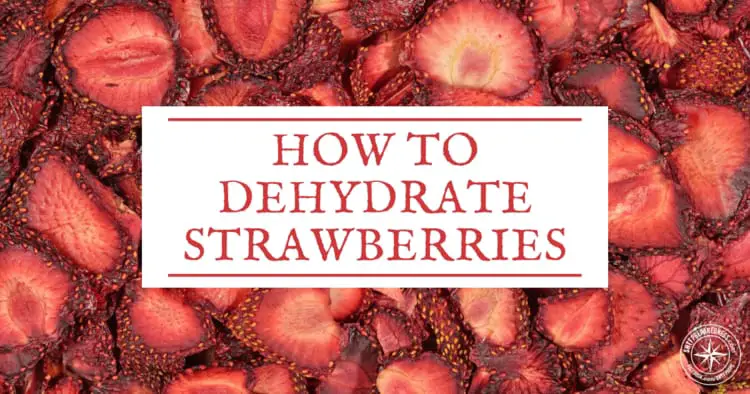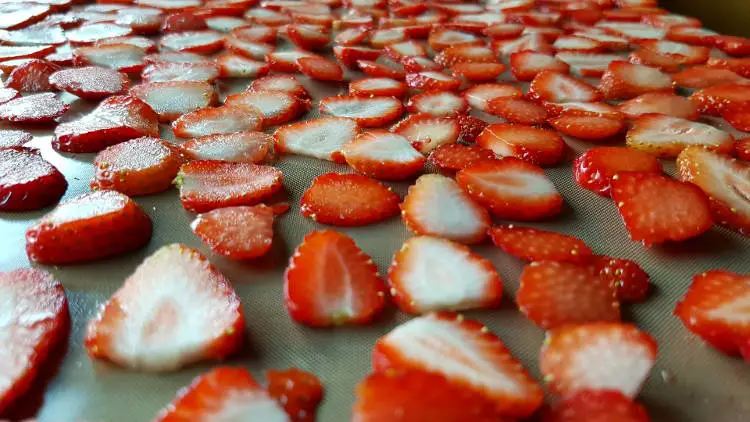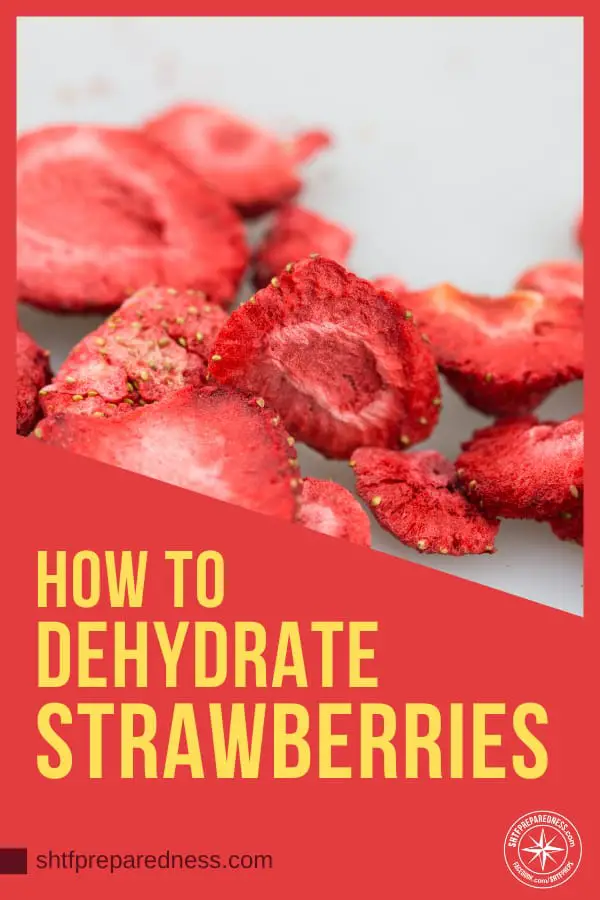On acres of tilled land, crimson strawberries grow in the late spring. Many farms allow U Pick opportunities for those who are into that type of thing.
If you’ve done this and you don’t know how to dehydrate strawberries or preserve them, well, you lose them.
Strawberries, at their peak, are such incredibly delicious fruits but they wither fast. Before long they get too soft and next comes the fuzz. Those strawberries are fleeting, aren’t they?
Even if you know how to best store strawberries, they will still go bad fast. It’s just the nature of this ripe fruit.
 The good news is, there are several ways to dehydrate strawberries. We are going to look at each of these methods.
The good news is, there are several ways to dehydrate strawberries. We are going to look at each of these methods.
Once you have dehydrated your strawberries you can even store them for the long term. Then they become an effective part of your food storage or meal prepping plan.
We will also look at how to grow strawberries. You know, the only thing better than picking someone else’s strawberries is to dehydrate and preserve your own. That is an incredible opportunity and one that is well within reach.
Health Benefits of Strawberries
Strawberries are red fruits. and because of that their health benefits are huge. Those red-skinned fruits and vegetables are all powerhouses. Strawberries are no different.
One of those rare fruits; Strawberries have positive health benefits for your entire body and beyond. They are also delicious! There is really no reason not to be eating them.
So, what are the health benefits of strawberries?
Boost Immunity
The presence of vitamin C, flavonoids and other antioxidants make strawberries the perfect fruit for boosting immunity.
This is important both for a SHTF situation and your daily life. Your immune system is so important.
Lower Blood Pressure
Because strawberries are so high in potassium they are a great means of dealing with high levels of sodium and fighting cardiovascular disease. In fact, potassium is a great means of making your whole machine run better.
Regulate Blood Sugar
In this age of radical excess, we struggle with diet-related diseases like diabetes. Of course, that comes down to regulating blood sugar. It’s a very important piece of the puzzle.
One of the nutrition benefits of strawberries is that they are low on the glycemic index. Which means you can enjoy their sweetness without a spike in blood sugar.
Fight Cancer Risk
Flavonoids may be an important factor in preventing cancer. The effective flavonoids, in particular, are called anthocyanins, quercetin, and kaempferol. They act as a battalion against the growth of cancers and tumors.
Along with all the other benefits, strawberries are also great for weight loss.
The benefits of strawberries should not be disregarded. Nor should the only way you preserve them be to douse them in sugar and pectin for jam.
How to Grow Your Own Strawberries
We are entering an age that will see more people growing and storing food than at any time in the last 50 years!
Now, this could come from necessity or it could come from the desire to effect change through self-sufficiency, nutrition, and clean food production.
What do I mean?
I am talking about growing your own food. Millions of people are growing their own food already. If you aren’t part of this revolution you could be.
Maybe you start by growing your own strawberries. They are not terribly difficult to grow but we will look at some tips for growing strawberries.
Tips for Growing Strawberries
Knowing when to plant strawberries is very important. Likewise, knowing where to grow them is important, as well.
Let’s look at the type of things you can do to have the most success in growing strawberries
Give Strawberries Plenty of Space
Be sure your plants have plenty of space between them. They will grow and spread. They can easily choke each other out.
Plant Them in Beds
Plant your strawberries in raised beds where you can control the soil makeup. This will assure you have just the right things in your soil to have a successful season.
Don’t Overwater
Strawberries are a spring plant. It will be raining, don’t overwater your plants. You see, these plants do not like to be bogged down with water. Be sure you also have well-draining soil.
Fertilize Your Plants
Fertilize your plants for the best results. When you fertilize, you are feeding your plants
Trim Runners
Your strawberries will give off runners as they grow. These will root and drain more nutrients from your plant. These need to be trimmed.
Pick the First Flowers
That first batch of flowers, no matter how beautiful, need to be picked off the plant. This will help the plant establish itself before creating fruit.
Protecting Strawberries
The most well balanced and prolific strawberry plants can be picked to nothing by squirrels, birds and other small creatures.
You aren’t the only one that loves the taste of them! So, you need a means of protection. Here are a few methods of keeping your strawberries safe.
- Grow them in a greenhouse
- Use protective netting
- Build a good fence
- Deter with scarecrows or other movement or sound creating devices
- Grow strawberries in PVC pipe
Don’t forget that strawberries are perennials so you can grow strawberries using strawberries.
How to Dehydrate Strawberries
Like all things, dehydrating strawberries is going to require the removal of as much moisture as possible.
Of course, strawberries are full of moisture. This means they are going to shrink quite a bit. This is actually great because it means you are going to be able to store even more of them in a smaller area.
Preparation
 Let’s learn how to make dehydrated strawberries.
Let’s learn how to make dehydrated strawberries.
Basic preparation of the strawberries is going to require you to rinse them, hull them or remove the green tops, dry them and slice them about a half-inch thick.
Lay them out on parchment on the trays you will dehydrate with and you should be ready to go.
There are three basic methods that can be used to dehydrate strawberries.
Solar Dehydration
It’s really not that tough to build your own DIY solar dehydrator. Solar dehydration is going to take the longest and that is because the heat varies and it basically shuts off after 8 good hours.
To get good dehydration on these strawberries you may need to go two full days in the sun when the weather is cool. In the hot weather, you could get it done on one good day.
Much of this is dependent on the type of solar dehydrator you are using. The good news is if they don’t seem to be dehydrated enough, just put them in there for another day!
Oven Dry
If you don’t have a dehydrator of any kind do not fret. You could use your own home oven to dry these strawberries out. An oven is a great tool for dehydration and its one that most people overlook.
It’s best to use wire racks because there is no real airflow in your oven. However, if you don’t have them you a just flip the berries about halfway through for the best results.
Your oven should have a warm setting if it’s electric. If you have a gas oven you don’t even need to turn it on. The pilot light is enough to dry these strawberries overnight. That is the small flame that stays lit so your gas-fired oven turns right on when you need it.
If your oven does not have a pilot light you will need to place the strawberries in the very middle of the oven on the lowest setting.
How long does it take to dehydrate strawberries in the oven? Well, I like to give it about 12 hours. Do it overnight and check them after breakfast.
If you want them drier just put them back in. It’s pretty easy to learn how to make dried strawberries in the oven, you control the process, for the most part!
Counter Top Dehydrator
If you are a fan of those delicious fruit chips that are crisp and dry, use a dehydrator.
Set your dehydrator to 135 degrees and place your trays into the machine. This process will take about 8-10 hours and will give you the very best results.
Don’t forget to prep your strawberries as we mentioned above.
8-10 hours is the recommended time but if the strawberries are not dry you always have the option to dehydrate them further. Give them another hour or two.
You could even look into dehydrating strawberries in an air fryer.
There are many methods that can be used to dehydrate strawberries. How long to dehydrate strawberries has much to do with the consistency that you prefer.
Long Term Storage of Dehydrated Strawberries
The process of long term food storage hinges on a few things.
There are only a few ways that your dehydrated strawberries can go bad. The first way is through moisture coming in contact with them.
The other way is through pests coming in contact with the berries. Pests carry disease and infest a food source.
Finally, you have oxidation. The very air surrounding your food is degrading it.
To combat all of this you are going to want to pack your strawberries like any other long term food storage.
The process will require mylar bags, O2 absorbers, and some sort of thick plastic container like a 5-gallon bucket with a lid. Thick plastic is best.
5 Gallon Heavy Duty Mylar Bags with 2000cc Oxygen Absorbers Individually Sealed (6)
Your dehydrated strawberries will go into the mylar bags. They will be stored with an O2 absorber based on the size of the bag. The mylar will need to be heat sealed which can be done using an iron or a hair straightener.
Finally, the bags will be piled into your bucket and the bucket sealed. Don’t forget to date those buckets so that you know how long the food has been inside!
If you do this in batches, year over year, it will be even more important to date them.
How Long Will Dehydrated Strawberries Last?
Now you know how to store dehydrated strawberries.
The question now is how long will dehydrated strawberries last. Of course, this has everything to do with the method you use to store the strawberries. You can do it in a number of ways.
We mentioned the long term storage method above. Your strawberries will last nearly 25 years with the right temperature conditions and storage. That number might even be conservative.
You can also store your strawberries in Ziplocs in the pantry and they will last at least a good year before they start to breakdown into powder. That might be conservative, as well.
You see, we get much more time with our food than the manufacturer’s expiration date indicates.
Dried strawberries are also great to keep in the freezer. The freezer is a nice dry area for foods like these. There is another perk to this method, too! They taste great when kept in a freezer, a little frozen treat!
Conclusion
Learning how to dehydrate strawberries will give you another weapon in your long term food storage arsenal.
While food storage might seem like a prepper thing to do. It’s also as much about eating well. What could be better than freshly picked strawberries that are dried and ready to eat whenever you want them?
Whether its the dead of winter or the middle of spring, you can have access to that strawberry flavor.
The processes of dehydration and preservation seem strange to us because we no longer need them to survive. However, it was just 100 years ago that these processes were essential to survival.
Funny how much convenience has cost us in our own heritage and skills.
Maybe this DIY project of dehydrating strawberries will not only give you something to do with all those extra strawberries but maybe it will reconnect you. We could all use a little connection with the past. Rough times are ahead and we all need to be prepared.
Every skill and every experience will add to your life and to your ability to adapt and overcome the struggles ahead.

